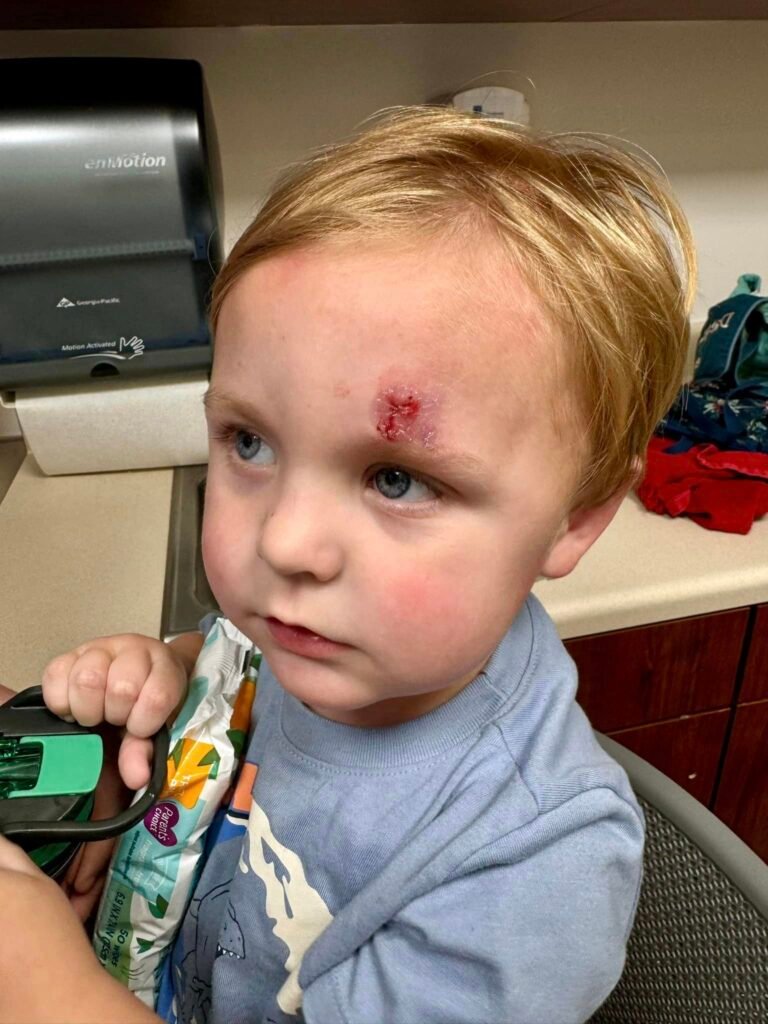While alarming in nature, head wounds often are not as serious as they seem. With small children, it can be frightening and stressful, but if you follow these easy steps, it can make the experience less overwhelming.
Overview:
Step 1- Remain calm.
Step 2- Assess the situation.
Step 3- Clean the wound.
Step 4- Apply pressure to stop bleeding.
Step 5- Cover the wound.
Step 6- Monitor wound and child’s behavior.
Step 7- Seek medical intervention.
Breakdown:
Step 1 Remain calm. A trick of the trade when it comes to being a child’s caregiver is downplaying everything. Freak out on the inside all you want, just don’t let that internal panic make an appearance and scare your child more. Head wounds bleed a lot, so they can appear worse than they are at times. You want to avoid distressing the child as much as possible.
Step 2 Assess the situation. You want to check for the severity—is the child conscious? Bleeding? Are there other injuries or signs of brain injury? If your child hits their head, always check if the spot is sunk inward—if so, treat this a serious situation and get immediate 911 help. If they hit their head and a huge knot forms, they’re usually okay. Ice packs help with swelling, but if the bump is concerning or there are other symptoms hinting at further injury, seek medical intervention.
Step 3 Clean the wound with clean water and removing any visible debris. You want to see how deep the cut goes. Is it a cut, or a gash? A superficial laceration can be handled with a Band aide. A gash typically affects the deep tissue and may need stitches or other medical intervention. (*If it’s a mouth injury, give the child sugar granules to pack into the cut in their mouth and it helps stop bleeding.)
Step 4 Apply pressure to stop the bleeding. Use a clean and sterile cloth or gauze for several minutes and elevate the head if possible. A wound that is deep may not stop bleeding for a long time and blood loss can become a problem if not monitored closely.
Step 5 Cover the wound. Grab whatever you have on hand, as long as its sterile as possible. Towel, washcloth, gauze or bandages, a clean t-shirt…
Step 6 Monitor wound and behavior. After a few minutes of applying pressure and monitoring your child, you should be looking for signs of concussion or brain injury—vomiting, loss of consciousness, confusion or disorientation, drowsiness or irritability, trouble paying attention, and much more, according to the Mayo Clinic.
Step 7 Seek professional, medical help if necessary. Dayton Children’s recommends taking a head laceration to a doctor if it is still bleeding after 5 minutes of pressure, if it is gaping or looks deep, is on your child’s face, lips, or neck, has glass or debris in it, has an object sticking out of it, or spurts blood. If it’s severe, call 911. If the bleeding is controlled and there are no further distressing symptoms, then you may drive to the nearest Emergency Room.
Cuts or Lacerations: Symptoms, Causes, Treatment, First Aid Tips & Prevention (emedicinehealth.com)
Concussion in children: What are the symptoms? – Mayo Clinic
When Does a Cut Need Stitches? | Dayton Children’s Hospital (childrensdayton.org)
My husband had never encountered a head injury before and he panicked, like many parents. I helped raise my nephew and worked with young children as a preschool teacher, so this was not my first rodeo, so to speak.
Our son made it to 3 without an ER trip, and I thought we were doing pretty good, but that record died a swift death one night when he was standing in our living room, munching on a hotdog and watching a movie with us. It was a late supper (we’d been working on home improvement all afternoon so we ate late and not at the table), and our son was standing beside the couch, eating. He turned around and lost his balance. When he fell forward, it was face-first into a tall candle holder we had sitting in front of the entertainment center. His forehead hit the sharp corner.

Of all the Evel Knievel stunts he’s pulled with climbing, running wild, and jumping off anything, he met his match while sedately turning in another direction. Go figure! He was crying hysterically, blood was pouring, and I knew automatically this was an ER trip. We applied pressure for several minutes, and it still was slowly bleeding and we could see it was pretty deep.

Because of my experience with head injuries, I was very calm and reassuring. He stopped crying after about 5 minutes and even held the hand towel to his gash on his own while we drove to the ER. It wasn’t until after we were almost to the hospital that I realized he had not relinquished his hold on his hotdog. It was clenched in his free hand and I had to talk him into letting it go so we could go inside. He was no longer bothered by the injury. He was more concerned about that hotdog.
Boys…face palm.
At 3 years old, our boy is stout. He is strong as an ox and as stubborn as one. It took two nurses wrapping a sheet around him and pinning him down to get medical glue applied to the wound, and even then, he was scooting them all across the bed as he fought them, but thankfully the doctor decided to try the glue over stitches. If they’d had to stitch him, I don’t know how they’d accomplish it.



It’s true what they say: there is less drama with boys, but they’re harder to keep alive than girls.

being a parent is a tough gig. It is NOT for the faint of heart. But we’re making it every single day. We got this, ladies and gentlemen. Mostly because we have no other choice, but it still counts!


Thanks for the article https://minecraftcommand.science/commands/83238 .